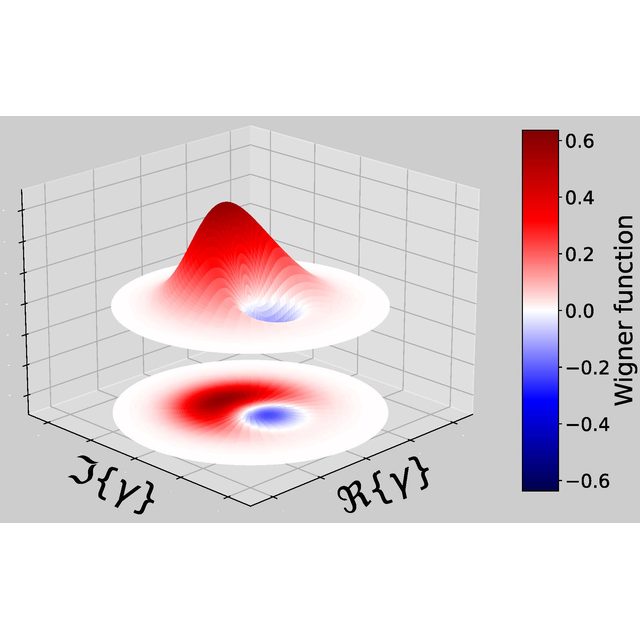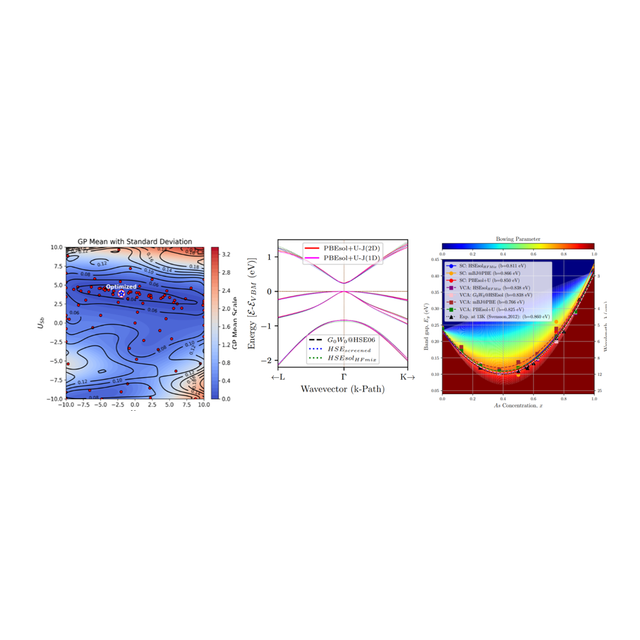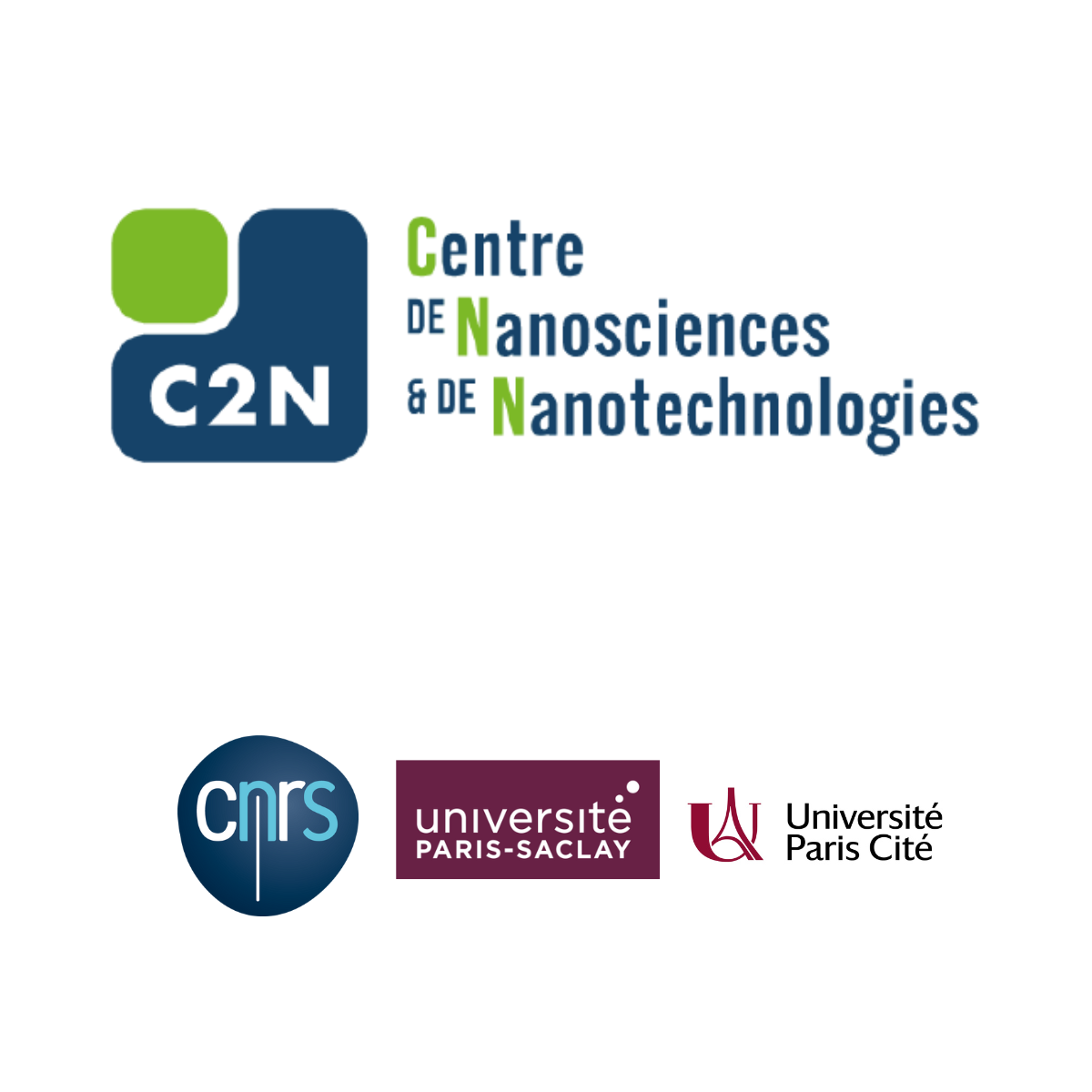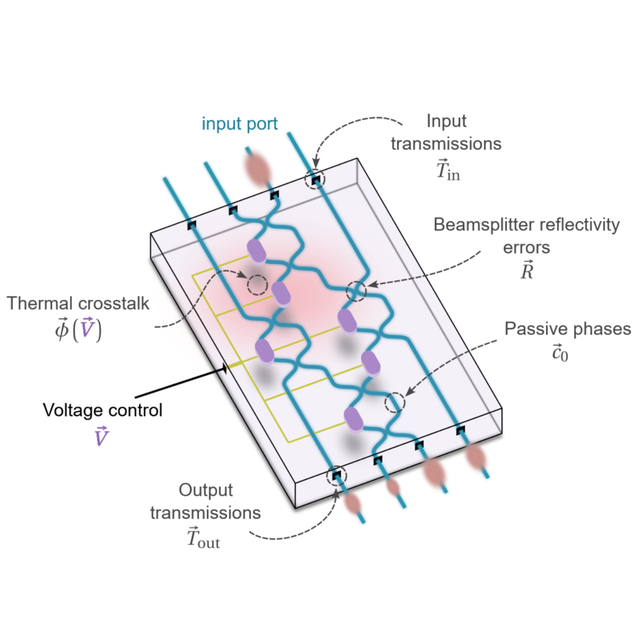
Soutenance de thèse

(en anglais) Coherent acoustic phonons in nanostructures: transduction, transport, and tunability
C2N - Centre de Nanosciences et de Nanotechnologies, , PalaiseauSoutenance de thèse
Coherent acoustic phonons are collective lattice vibrations with a well-defined phase. Their ability to couple with various excitations makes them attractive for interfacing different solid-state platforms, while their slow propagation speed enables signal processing and information storage in compact devices. In this thesis, we develop three nanophononic devices that address coherent phonon generation and detection, propagation control, and tunability. We introduce elliptical micropillar optophononic resonators that lift the degeneracy of optical cavity modes in energy and polarization. By combining this property with a cross-polarization-scheme pump-probe experiment, the generation and detection of coherent acoustic phonons are simultaneously enhanced. We design a phononic waveguide and demonstrate a quasi-continuous source of acoustic phonons at 20 GHz. We observe phonon propagation over 20 μm and demonstrate spatio-temporal coherent control of guided phonons. And finally, we design acoustic resonators incorporating mesoporous thin films and use their stimuli-responsive properties to achieve tunability of acoustic resonances through external environmental control. These three nanophononic devices serve as basic building blocks for phononic networks and advance the control of coherent acoustic phonons for classical and quantum applications.

(en anglais) Wigner functions of Quantum Light emitted by Quantum Dot Sources
C2N - Centre de Nanosciences et de Nanotechnologies, Amphithéâtre,Soutenance de thèse
Semiconductor quantum dots have emerged as excellent single-photon sources for optical quantum technologies. When inserted in an optical cavity, they have been shown to deterministically emit pure, indistinguishable single photons on demand with high emission rates. Quantum dot single-photon sources have so far been used to process the quantum information that is encoded in the discrete modes of the single photons; a framework known as discrete-variable encoding. Alternatively, the quantum information can be encoded on the continuous quadratures of the optical field in the continuous-variable framework. With their ability to generate deterministically complex non-Gaussian states of light and to provide optical non-linearity at the single-photon level, quantum dots in cavities could also bring new opportunities to process the information in continuous-variable approach.
In this Ph.D. thesis, we take the first step toward positioning our quantum dot sources as potential resources for continuous-variable optical quantum technologies. We report on the first Wigner function measurement of the single-photon state and photon-number superposition states generated by an optical solid-state quantum emitter. We achieved this goal by overcoming key challenges in operating in the low-transmission regime and in adjusting measurement techniques to the high rate of our single-photon sources: (i) the optimization of the quantum interference between the local oscillator (a weak coherent state) and the photonic states emitted by our quantum dot device, which leads to optimal displacement operations, (ii) the correction of photon loss, and (iii) the reconstruction of photon-number distribution from single-photon detection.

(en anglais) Shaping tungsten dichalcogenides properties by chemical vapor deposition of alloys and polytypes
C2N - Centre de Nanosciences et de Nanotechnologies, , PalaiseauSoutenance de thèse
Two-dimensional (2D) transition metal dichalcogenides (TMDs) present varied optical and electronic properties associated with their different crystal structures. We optimize here the chemical vapor deposition (CVD) of tungsten-based TMDs, such as hexagonal (1H) WSe2 and WS2 monolayers, as well as monoclinic (1T’) WTe2. While 1H WSe2 and WS2 are typically direct band-gap semiconductors in the monolayer form, the anisotropic 1T' WTe2 is a small band gap topological insulator. Our purpose is to study the structural and electronic phase transition of ternary alloy WSe2xTe2(1-x) between the 1H and 1T' crystal structures. However, the synthesis of the mid-composition (x~0.5) alloys by CVD remains challenging. By just adding an additional monolayer, we obtain bilayer (2ML) structures, in which the available polytypes combinations, and the relative physical properties, are even richer. We further optimize our CVD growth methods to maximize the yield of 2ML hexagonal WSe2 and WS2. In addition to Raman and photoluminescence spectroscopies, we employ various other experimental techniques, including second harmonic generation and selective area electron diffraction, to discern between the 2ML polytypes. We then focus on the 3R bilayer stacking of WSe2 and we resolve its electronic band structure by angle-resolved photoemission spectroscopy.

(en anglais) Machine Learning-Driven First-Principles Modeling of Far-Infrared Materials
C2N - Centre de Nanosciences et de Nanotechnologies, ,Soutenance de thèse
Abstract
This thesis focuses on the modeling of narrow-gap far-infrared semiconductors, ternary alloys, and heterovalent heterostructures. To overcome the limitations of conventional Density Functional Theory (DFT), a Bayesian Machine (BMach) framework [2] is developed to optimize internal DFT meta-parameters, such as the Hubbard U in DFT+U and the mixing (α) and screening (μ) parameters in hybrid exchange–correlation functionals. These parameters are benchmarked against quasiparticle corrections obtained from Green’s function–based quasiparticle-GW (G₀W₀) calculations, with BMach employing Gaussian process regression (GPR) and physics-informed loss functions.
Applied to the benchmark semiconductors InSb and InAs, BMach accurately reproduces experimental band gaps, effective masses, and Luttinger parameters at significantly reduced computational cost [1]. The study further explores CuPt-ordered InAsₓSb₁₋ₓ alloys across the full composition range using both supercell and Virtual Crystal Approximation (VCA) approaches; notably, the VCA-based G₀W₀ method yields a bowing parameter of 0.838 eV, in excellent agreement with experiment. Finally, the band alignment at the CdTe/InSb(001) heterointerface is determined using the potential-lineup method with BMach-calibrated parameters, confirming a type-I alignment consistent with experimental observations.
This work establishes a transferable and extensible computational framework for high-fidelity electronic-structure predictions across diverse material systems, with direct relevance for future electronic, optoelectronic, energy, and quantum technologies.

Accélérateurs de particules sur puce
C2N - Centre de Nanosciences et de Nanotechnologies, , PalaiseauSoutenance de thèse
La présente thèse explore le développement d’un accélérateur de particules miniaturisé intégré sur une puce en silicium, en réponse aux défis posés par les infrastructures colossales et les coûts élevés des accélérateurs conventionnels (CERN, XFEL, SOLEIL). S’appuyant sur le concept des accélérateurs lasers diélectriques, le dispositif proposé exploite l’interaction entre un faisceau d’électrons et un champ électrique confiné dans une cavité à cristal photonique. Ce principe repose sur l’accord de phase entre la vitesse des électrons et celle du champ, rendu possible grâce à une conception précise de nanostructures en silicium suspendu, offrant un fort confinement optique, un faible volume modal et une compatibilité avec les techniques de fabrication de l’industrie des semi-conducteurs. Le travail de recherche comprend : la conception et la modélisation des cristaux photoniques pour optimiser l’accord de phase et le transfert d’énergie, le développement d’une solution innovante de couplage optique par injection fibrée adaptée aux contraintes d’un microscope électronique à transmission et la mise en place d'une solution technologique afin d'éviter l'accumulation de charges sur la structure lors du passage du faisceau d'électrons. Les structures ont été fabriquées en salle blanche par des techniques avancées de nanofabrication. Les dispositifs réalisés ont été caractérisés par des mesures de leur facteur de qualité, de leur fréquence de résonance et par des expériences d’EELS, permettant d’évaluer l’efficacité du couplage entre les électrons et les modes des cavités. L’efficacité du couplage optique de la structure fibre-puce développée a également été mesurée afin d’optimiser les performances du dispositif. Les résultats obtenus dans cette thèse contribuent de manière générale à la photonique silicium et plus particulièrement à la démonstration du fort potentiel des structures développées pour l’accélération de particules sur puce et ouvrent la voie à des applications prometteuses en physique des hautes énergies, en imagerie et dans le développement de sources de rayonnement compactes.

(en anglais) High-fidelity photonic quantum information : protocols and universal circuit control
C2N - Centre de Nanosciences et de Nanotechnologies, , PalaiseauSoutenance de thèse
Abstract
In this PhD thesis, we advance integrated photonics for quantum information processing by improving the calibration and control of photonic integrated circuits (PICs). PICs enable compact and stable light manipulation for a wide range of applications in optics. We demonstrate quantum protocols on specialized PICs, including the first on-chip certified randomness generation and high-fidelity 4-GHZ state tomography. In universal PIC architectures, we develop a machine learning-assisted characterization technique to mitigate hardware imperfections, achieving a record 99.77% fidelity in unitary operations on a 12-mode interferometer. Finally, we refine crosstalk models and propose a robustness criterion for interferometer design, enhancing PIC control accuracy. Our results, including a patented machine learning-based method, contribute to both quantum and classical integrated photonics, advancing scalable photonic quantum computing.
Figure : Photonic integrated circuits (PICs) consist of waveguides (blue lines) guiding light across a slab of transparent material. PICs often exhibit various imperfections resulting from fabrication constraints, tolerances, and operation wavelength, illustrated here on a simplified PIC. In general, input and output ports have different optical transmissions. In addition, the actual beamsplitter reflectivity values deviate from the target. Phase shifters (purple components) dissipating heat entail that all the implemented physical phase shifts depend on all the applied voltages. Finally, optical path variations lead to non-zero phase shifts even without any voltages applied. We use machine-learning to find suitable values for each of these parameters.